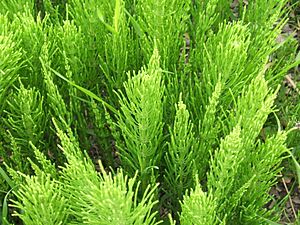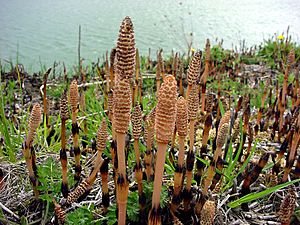Field horsetail facts for kids
Quick facts for kids Field horsetail |
|
|---|---|
 |
|
| Photosynthetic summer branches | |
| Scientific classification | |
| Genus: |
Equisetum
|
| Species: |
arvense
|
| Synonyms | |
|
|
Equisetum arvense, also known as field horsetail or common horsetail, is a special type of plant. It's a perennial plant, meaning it lives for more than two years. It belongs to the horsetail family and grows naturally in cool and mild parts of the northern hemisphere, like the arctic and temperate regions.
This plant has two different kinds of stems. Some stems are for making spores (like seeds for plants), and others are for growing and making food. Both types of stems grow from a long underground stem system called a rhizome. The rhizomes can grow very deep, up to 6 feet (about 1.8 meters) into the soil. This helps the plant survive in many different places and makes it hard to remove.
Contents
What's in a Name?
The scientific name arvense comes from a Latin word, "arvum." This word means "ploughed field." It describes how the plant often grows in farm fields or places where the soil has been disturbed.
The common name "common horsetail" describes what the plant looks like. When its branches are grouped together, they look a bit like a horse's tail!
What Does it Look Like?
Equisetum arvense spreads widely using its thin, branching rhizomes. These rhizomes also grow small tubers, which are like tiny storage bumps.
The green stems that grow above ground can be from 10 to 90 centimeters (about 4 to 35 inches) tall. They are about 3 to 5 millimeters wide. These stems have joints, like bamboo, with smaller side shoots growing out in circles at each joint. Some stems can have as many as 20 jointed sections!
The stems that produce spores are different. They are usually off-white and look a bit fleshy. They grow 10 to 25 centimeters (about 4 to 10 inches) tall and are also 3 to 5 millimeters wide. These spore-producing stems appear in early spring and have brown scale-like leaves. At the very top, they have a brown cone that holds the spores. This cone is about 10 to 40 millimeters long.
This plant has changed very little from its ancient relatives that lived during the Carboniferous period, millions of years ago.
How it Reproduces
Equisetum arvense does not make flowers or seeds. Instead, it multiplies using spores. It also spreads very well through its underground rhizomes and tubers. This makes it a very tough plant to get rid of. Even if you cut it down or try to burn it, new stems can quickly grow back from the rhizomes.
A cool fact about this plant is that it absorbs silicon from the soil. This is quite rare for plants! It also has a very high number of chromosomes, 216 in total.
Where Does it Grow?
Field horsetail can grow in many different places. It can handle temperatures from below 5°C (41°F) to over 20°C (68°F). It also grows in areas with low rainfall (as little as 100 mm per year) or very high rainfall (up to 2000 mm per year).
You can often find it in:
- Damp, open woodlands
- Pastures and farm fields
- Along roadsides
- Disturbed areas (like construction sites)
- Near the edges of streams
It prefers soils that are neutral or slightly basic, especially clay loams that are sandy or silty, and where the water level underground is high.
This plant is very common in the northern hemisphere. It grows as far north as 83° in North America and 71° in countries like Norway and Russia. It also grows as far south as Texas, India, and Iran. It's less common in the southern hemisphere, but you can still find it in places like Argentina, Australia, and New Zealand.
Helpful Uses of Horsetail
This plant contains many useful substances. It is rich in silicon, potassium, calcium, and other minerals like manganese, magnesium, and phosphorus. It also has vitamins A, E, and C, and other natural compounds.
In Japan and Korea, the young buds of Equisetum arvense are sometimes eaten as a vegetable in the spring. However, it's important to know that all other types of Equisetum species can be toxic, so only Equisetum arvense is sometimes used this way.
Historically, people have used field horsetail for different purposes:
- It was traditionally used on the skin for chilblains (sore spots from cold) and wounds.
- It was once used to polish pewter and wood, which is why it was sometimes called pewterwort.
- It was also used to strengthen fingernails because of its silicon content.
- Because it's a bit abrasive, it was used by musicians who played the hurdy-gurdy to clean their instrument's wheels.
Some farmers use Equisetum in a special type of farming called biodynamic farming. They use it to help reduce problems caused by too much water around plants, like fungal growth. The high silica in the plant helps with this.
In traditional Austrian herbal medicine, E. arvense was used as a tea or in baths to help with skin problems, joint issues, and kidney or urinary tract problems.
Harmful Effects
While it has some uses, Equisetum arvense can be harmful. It is toxic to farm animals, especially horses, if they eat too much of it.
This plant was brought to New Zealand in the 1920s. It was later identified as an invasive species there, meaning it spreads quickly and can harm native plants. Because of this, it is now on the National Pest Plant Accord in New Zealand, which means it cannot be sold, spread, or grown there.
Images for kids
See also
 In Spanish: Equiseto o cola de caballo para niños
In Spanish: Equiseto o cola de caballo para niños




